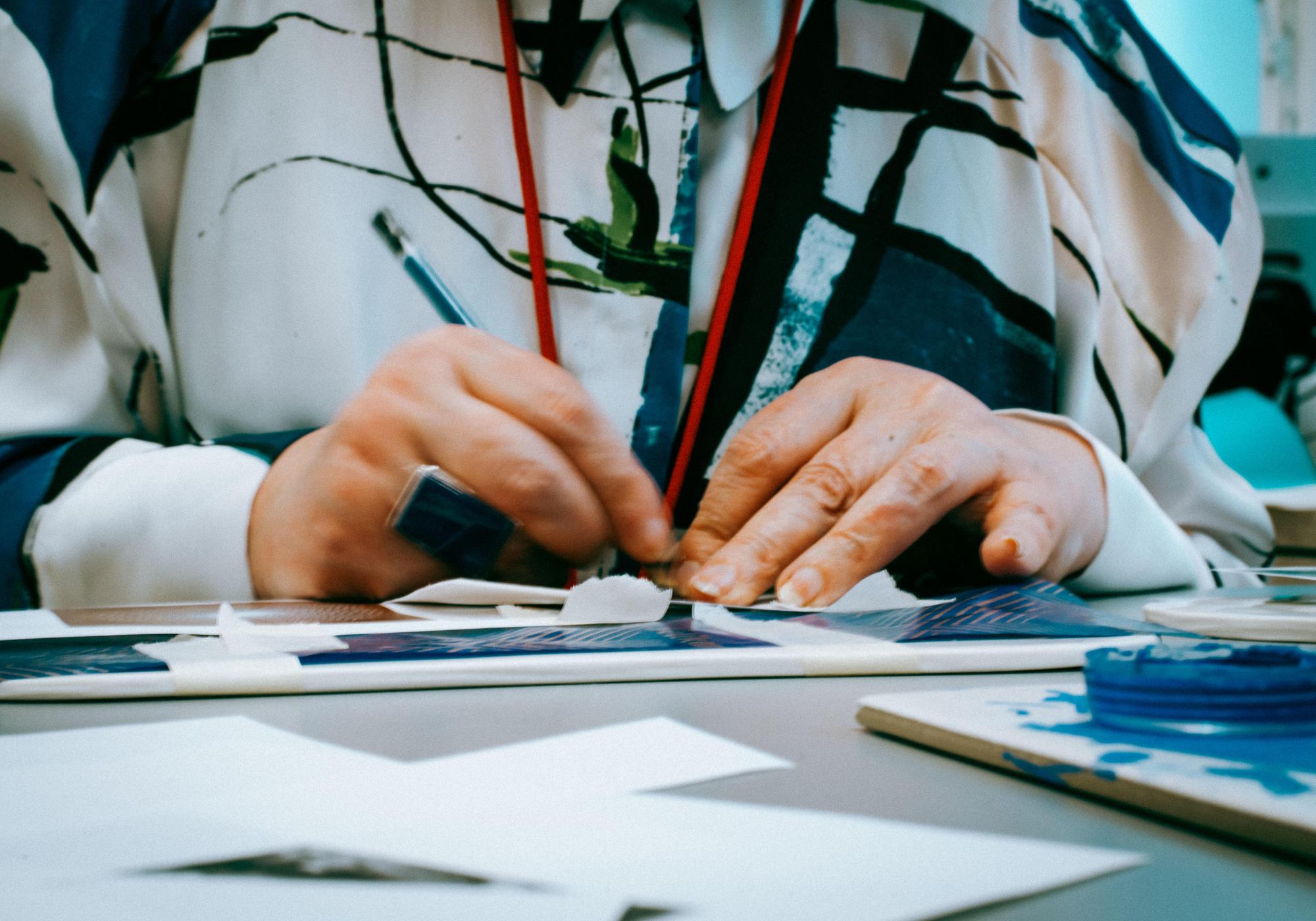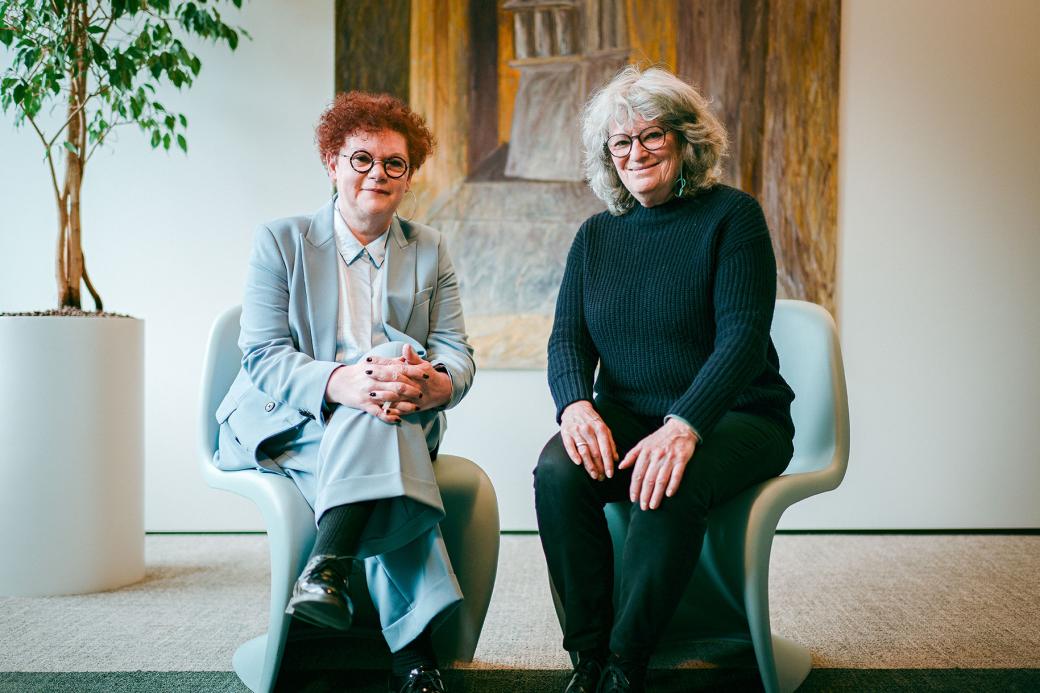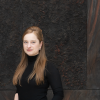1001 Plateaux: Participatory artwork connects NBB employees

On the first mild spring evening in March, in one of the NBB’s meeting rooms, fifteen heads are bent over fifteen white ceramic trays, brushes dipped in blue paint at the ready. There will be painting, conversation and lots of laughter. Each tray will form part of a participatory artwork entitled 1001 Plateaux, which will be comprised of 160 trays in total. Walking amongst the tables is the artist who came up with the idea, Françoise Schein, who has achieved international recognition for her “participatory artworks”. She normally works in cities, such as metro stations from Brussels to Lisbon or the favelas of sprawling Brazilian metropolises, like São Paulo, Rio de Janeiro and Brasília. But she feels right at home at the Bank. “The process of learning to paint is a great equaliser,” she explains. “I’m an artist, and I love teaching!”
What is art?
In 2019, Carine Fol, the external advisor to the Bank for its contemporary art collection, proposed the idea of a participatory artwork, to which Bank employees would actively contribute. “What is the role of art,” asks Carine, “specifically, the role of collections like the Bank’s and the museum’s in the daily lives of its personnel. I wanted a work that would connect the contemporary art collection of the Bank and the historic collection of the Museum with the people who work in the presence of and among these objects. The process leading to the final work was particularly important in this respect.” Carine’s proposal was deemed a perfect fit with the Bank’s search for a unifying cultural project and was therefore given the green light.
Carine then reached out to Françoise Schein, with whom she had worked before. Françoise is passionate about human rights. She makes monumental artworks with local residents and schoolchildren in metropoles around the world. “It started in my Paris studio in Belleville,” she says. “Children from the neighbourhood’s Muslim community would regularly drop by for a yoghurt and to comment on my sculptures. This interaction was very important for my work, because despite their lack of savoir faire, they had remarkably interesting things to say. I suddenly saw connections between my work, the world, things I read and those children. These worlds are not separate at all, but can overlap, if you want them to.”

The Bank’s collections as the special of the day
How did the idea for 1001 Plateaux come about? “After a tour of the Museum and the Bank’s art collection, which is scattered throughout a labyrinth of corridors and offices, we went to eat in the canteen,” Françoise explains. “There, everyone takes a tray, chooses a dish and sits down with colleagues. This experience gave me the idea of composing an ensemble of trays, on which employees could paint objects from the collections of the Bank. In this way, the collections become food for thought! For the trays, I developed organic forms in ceramic. Together, we interpret and paint objects from the collections on them, based on a number of artworks I selected together with the collection curators. We invited 160 employees to take part, as 1001 would have been a bit too many. Each person chooses an artwork and paints their interpretation of it on a tray. It can be an enlarged detail or a new concept; they are free to choose. I will add the finishing touches - words and visual elements that came up during the workshops - at my studio in Paris.”
Like grass or bamboo
The artwork will consist of 160 trays and not 1001, so why the title? Françoise explains: “It’s a reference to the book Mille plateaux by philosopher Gilles Deleuze. He introduced the concept of rhizomatic thinking, as opposed to hierarchical thinking. A society can function in two ways: hierarchical and centralist, like a tree with a trunk, branches and leaves, or rhizomatic, like grass or bamboo, plants without a centre that grow in all directions. I work like grass: I place everything at the same level. All trays, all persons are interconnected. There is no centre, and everyone is equal. The title 1001 Plateaux is also a nod to One Thousand and One Nights, to the poetic power of the work.” This power will continue to resonate throughout the Bank, she predicts. “The creation of a participatory artwork which will form part of the Bank’s contemporary art collection acts as a trait d’union that transcends hierarchy. Art is a part of life.”
A village of sorts
Did the artist experience culture shock when she came to the Bank? Not at all. “I arrived in a village,” she says, “a small village, in which I work with 160 inhabitants. And they are all quite different. There are many women and many people with foreign roots. It’s a magnificent village. I have also had many wonderful encounters, sometimes with real artists. I didn't expect that. ‘I work for the Bank and I’m also an artist’, so, yes, it is possible! People have many facets.”
In short, Françoise is incredibly pleased with the project. “Every time I take a batch of 15 trays back to my Paris studio, I examine them and I know that the finished product will be superb.” The project has also given rise to a nice sequel as the grant she receives for 1001 Plateaux, in the framework of the NBB’s patronage policy for (living) Belgian artists, will be used to sponsor new projects in Brazilian favelas. This is a shining example of how one good deed begets another and of how an institution like the National Bank of Belgium can become a communicating vessel with underprivileged youth in Brazilian favelas.
The NBB's participatory artwork is still a work in progress and will be on display to the public as from 8 September 2023 in the Bank’s central hall. More information will follow!
Françoise Schein (1953, Brussels) is an architect, urban planner, sculptor and conceptual artist. Human rights are the main theme of her work, which she displays in various ways in metro stations and on the walls of cities around the world, including Brazilian favelas, often in close collaboration with local residents and schoolchildren.
Carine Fol (1961, Anderlecht) holds a PhD in art history (VUB-ULB) and is a curator and author. In her projects, she builds bridges between works from the professional art world and outsider art and defends a vision in which the human being is at the centre of the creative process. She has worked for several cultural institutions in Brussels (Botanique, Goethe Institute, the Royal Museums of Fine Arts) and was the director of the Art & Marges Museum and artistic director of the CENTRALE for contemporary art. Since 2018, she has served as an external advisor to the Bank on its contemporary art collection.


